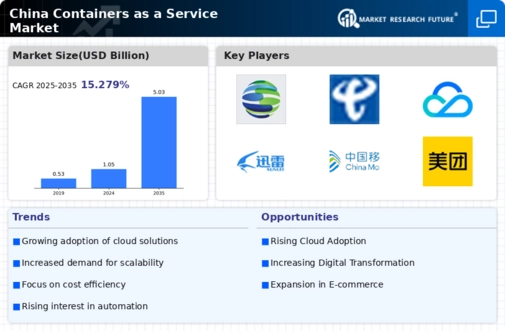The containers as-a-service market exhibits a dynamic competitive landscape, characterized by rapid technological advancements and a growing demand for scalable cloud solutions. Key players such as Amazon Web Services (US), Microsoft (US), and Alibaba Cloud (CN) are at the forefront, leveraging their extensive infrastructure and innovative capabilities to capture market share. Amazon Web Services (US) focuses on enhancing its service offerings through continuous innovation, while Microsoft (US) emphasizes strategic partnerships and integrations to bolster its Azure platform. Alibaba Cloud (CN), on the other hand, is expanding its reach within Asia, capitalizing on the region's burgeoning digital economy. Collectively, these strategies foster a competitive environment that is increasingly driven by technological prowess and customer-centric solutions.
In terms of business tactics, companies are increasingly localizing their operations to better serve regional markets, optimizing supply chains to enhance efficiency and responsiveness. The market structure appears moderately fragmented, with a mix of established players and emerging startups vying for attention. The collective influence of these key players shapes the competitive dynamics, as they engage in aggressive marketing and service differentiation to attract diverse customer segments.
In October 2025, Amazon Web Services (US) announced the launch of its new container orchestration service, designed to simplify the deployment and management of containerized applications. This strategic move is likely to enhance its competitive edge by providing customers with a more streamlined experience, thereby reinforcing its position as a leader in the market. The introduction of this service aligns with the growing trend towards automation and efficiency in cloud computing, suggesting that AWS is keen on addressing the evolving needs of its clientele.
In September 2025, Microsoft (US) unveiled a significant upgrade to its Azure Kubernetes Service, incorporating advanced AI capabilities to optimize resource allocation and performance. This enhancement not only strengthens Microsoft's service offering but also reflects a broader industry trend towards integrating AI into cloud solutions. By prioritizing AI-driven functionalities, Microsoft positions itself as a forward-thinking player, likely to attract enterprises seeking innovative solutions to complex challenges.
In August 2025, Alibaba Cloud (CN) expanded its partnership with local tech firms to enhance its container services, focusing on improving security and compliance features. This strategic collaboration underscores Alibaba's commitment to addressing regional regulatory requirements while enhancing its service portfolio. By aligning with local partners, Alibaba Cloud is poised to strengthen its market presence and cater to the specific needs of Chinese enterprises, which may further solidify its competitive standing.
As of November 2025, the competitive trends within the containers as-a-service market are increasingly defined by digitalization, sustainability, and the integration of AI technologies. Strategic alliances are becoming pivotal, as companies seek to leverage complementary strengths to enhance their offerings. Looking ahead, competitive differentiation is likely to evolve, shifting from traditional price-based competition to a focus on innovation, technological advancements, and supply chain reliability. This transition suggests that companies will need to invest in cutting-edge solutions and robust partnerships to maintain their competitive edge in an ever-evolving landscape.

















Leave a Comment